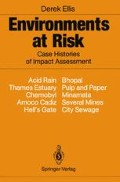Abstract
A pulp and paper mill is a factory producing organic chemicals. It starts with biological materials, trees, and processes them into woodfibre — in a form which can be exported as rolled-up strips of solid pulp, or its byproduct, paper. Along the way, organic materials are inevitably wasted and lost — these include beneficial nutrients, dangerously changed hydrocarbons (chlorinated), and smothering woodfibre (Fig. 5.1). The wastes also include a mix of toxic chemicals used in the pulping and paper-making processes, such as chlorine and zinc. Finally, there are natural inorganic toxins wasted — different trees have bioaccumulated different trace metals from their ecosystem as they grew.
“… the wastes from a pulp and paper mill have a triple whammy for the environment. They can poison; they can suffocate; and they can enrich. They also grow up crops of bacteria, and they smell horrible — both the liquid effluent and stack gases.”
Access this chapter
Tax calculation will be finalised at checkout
Purchases are for personal use only
Preview
Unable to display preview. Download preview PDF.
References
Bernard DP, Marmorek DR, Sutherland GD, Groves S (1987) Marine environmental effects monitoring programme: design and evaluation for Pacific coastal pulp mills. Rep Environ Can, Environ Protect Serv ME-2, 107 pp
Cooper WS (1926) The fundamentals of vegetational change. Ecology 7(4):391–413
Cross SF, Ellis DV (1981) Environmental recovery in a marine ecosystem impacted by a sulfite process pulp mill. J Water Pollut Contamin Fed 53(8): 1339–1346
Ellis DV (1977) Pollution control regulations and monitoring technology: a review of research and development from the pulp and paper industry. Prog Water Technol 9:673–682
Ellis DV, Ostrovsky I (1983) The bacterial sulphuretum: does it exist at Harmac? Environ Protect Serv Can, Worksh, Vancouver
Ellis DV, Gee P, Cross S (1981) Recovery from zinc contamination in a stock of Pacific oysters Crassostrea gigas (Thunberg). Wat Pollut Res J Can 15(4):303–310
Hutchinson AH, Lucas CC (1927) Report on the waters of Quatsino Sound, Alice Arm, the effect of the pulp mill at Port Alice. Biol Board Can, Ms Rep, 324 pp
Kay BH (1986) West coast marine environmental quality: technical reviews. Environ Can Reg Prog Rep 86–01, 154 pp
Hutchinson AH, Lucas CC (1927) Report on the waters of Quatsino Sound, Alice Arm, the effect of the pulp mill at Port Alice. Biol Board Can, Ms Rep, 324 pp
Pearson TH (1981) The Loch Eil project: introduction and rationale. J Exp Mar Biol Ecol 55:93–102
Pearson TH (1982) The Loch Eil project: assessment and synthesis with a discussion of certain biological questions arising from a study of the organic pollution of sediments. J Exp Mar Biol Ecol 57:93–124
Pearson TH, Rosenburg R (1978) Macrobenthic succession in relation to organic enrichment and pollution of the marine environment. Oceanogr Mar Biol Annu Rev 16:229–311
Pearson TH, Stanley SO (1979) Comparative measurement of the redox potential of marine sediments as a rapid means of assessing the effect of organic pollution. Mar Biol 53:371–379
Postgate JR, Kelly DP (eds) (1982) Sulphur bacteria. R Soc London, 172 pp. Philos Trans R Soc London Ser B 293:431–602
Rosenburg R (1972) Benthic faunal recovery in a Swedish fjord followinga closure of a sulphite pulp mill. Oikos 23:92–108
Rosenburg R (1973) Succession in benthic macrofauna in a Swedish fjord subsequent to the closure of a sulphite pulp mill. Oikos 24:1–16
Waldichuck M (1956) Basic productivity of Trevor Channel and Alberni Inlet from chemical measurements. J Fish Res Board Can 13(l):7–20
Waldichuk M (1958) Some oceanographic characteristics of a polluted inlet in British Columbia. J Mar Res 17:536–551
Waldichuk M (1983) Pollution in the Strait of Georgia. Can J Fish Aquat Sci 40:1142–1167
Waldichuk M (1988) Prediction of environmental effects based on invalid assumptions. Mar Pollut Bull 19(2):45–46
Young RH (1986) Receiving water responses to dispersion of kraft mill effluent from submarine diffuser in Northumberland Channel, British Columbia — a review. BC Water Waste Assoc Annu Conf, Nanaimo, 2 pp
Author information
Authors and Affiliations
Rights and permissions
Copyright information
© 1989 Springer-Verlag Berlin Heidelberg
About this chapter
Cite this chapter
Ellis, D. (1989). Organic Chemicals, Pulp and Paper — Annat Point (Scotland). In: Environments at Risk. Springer, Berlin, Heidelberg. https://doi.org/10.1007/978-3-642-74772-4_5
Download citation
DOI: https://doi.org/10.1007/978-3-642-74772-4_5
Publisher Name: Springer, Berlin, Heidelberg
Print ISBN: 978-3-540-51180-9
Online ISBN: 978-3-642-74772-4
eBook Packages: Springer Book Archive

